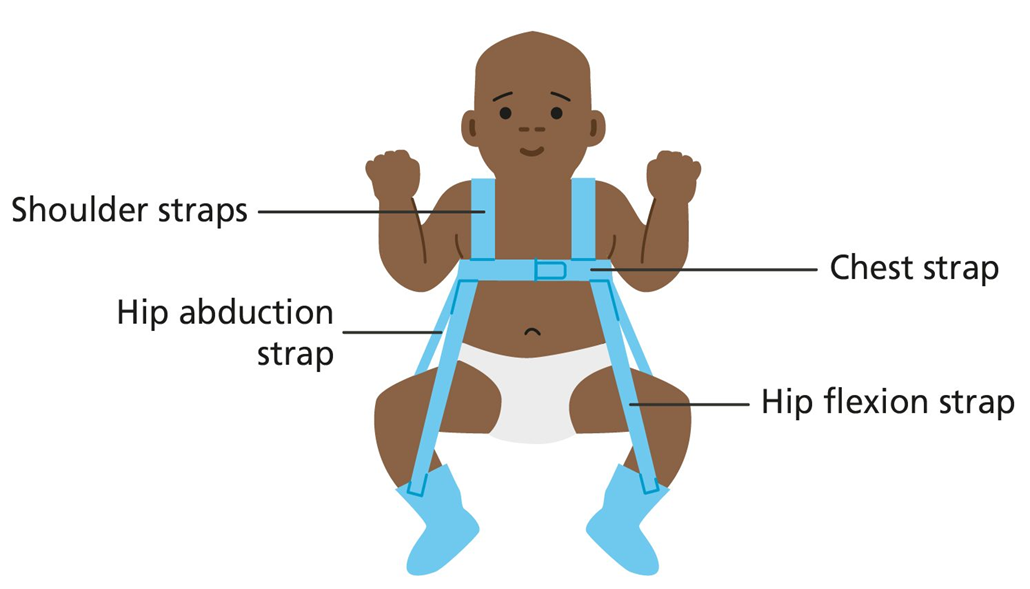The nurse is teaching a family how to care for their infant in a Pavlik harness to treat developmental dysplasia of the hip. Which instruction should be included in the teaching?
Remove harness several times a day to prevent contracture.
Place superabsorbent disposable diaper over the harness.
Return to the clinic every 12 weeks for adjustment of the harness.
Apply lotion or powder to minimize skin irritation.
The Correct Answer is B
Choice A reason:
Removing the harness several times a day is not recommended. The Pavlik harness should be worn continuously as prescribed by the doctor to ensure proper hip development. Removing it frequently can disrupt the treatment and may lead to complications.
Choice B Reason:
Placing a superabsorbent disposable diaper over the harness is important to keep the harness clean and dry. This helps prevent skin irritation and maintains hygiene. It is essential to ensure that the diaper is properly positioned to avoid any interference with the harness.

Choice C Reason:
Returning to the clinic every 12 weeks for adjustment of the harness is not accurate. Typically, follow-up visits are more frequent, especially in the initial stages of treatment. Regular adjustments are necessary to ensure the harness is fitting correctly and effectively promoting hip development.
Choice D Reason:
Applying lotion or powder to minimize skin irritation is not recommended. Lotions and powders can accumulate and cause further irritation or infection. Instead, keeping the skin clean and dry is the best way to prevent irritation while using the Pavlik harness.
Nursing Test Bank
Naxlex Comprehensive Predictor Exams
Related Questions
Correct Answer is ["2"]
Explanation
Calculation Steps
Step 1: Determine the total urine output in mL.
- Total urine output = 360 mL
Step 2: Determine the child’s weight in kg.
- Weight = 15 kg
Step 3: Determine the time period in hours.
- Time = 12 hours
Step 4: Calculate the urine output in mL/kg/hour.
- Urine output (mL/kg/hour) = Total urine output ÷ (Weight × Time)
Step 5: Perform the multiplication inside the parentheses first.
- Weight × Time = 15 kg × 12 hours = 180 kg·hours
Step 6: Perform the division.
- Urine output (mL/kg/hour) = 360 mL ÷ 180 kg·hours = 2 mL/kg/hour
Result
The child’s urine output is 2 mL/kg/hour.
Correct Answer is B
Explanation
Choice A reason:
Compartment syndrome is a condition where increased pressure within a muscle compartment leads to decreased blood flow, which can cause muscle and nerve damage. It is typically associated with severe trauma, fractures, or crush injuries. The symptoms include severe pain, swelling, and decreased sensation or movement in the affected limb. In this case, the child’s symptoms of redness, swelling, and tenderness following a spider bite, along with an elevated WBC, are more indicative of an infection rather than compartment syndrome.
Choice B Reason:
Osteomyelitis is an infection of the bone, which can occur following an injury or infection elsewhere in the body. The symptoms include redness, swelling, tenderness, and pain in the affected area, along with fever and elevated WBC. Given the child’s history of a spider bite and the presence of redness, swelling, tenderness, and elevated WBC, osteomyelitis is the most likely diagnosis. The unremarkable X-ray does not rule out osteomyelitis, as early stages of the infection may not show changes on X-ray.
Choice C Reason:
Osteogenesis imperfecta, also known as brittle bone disease, is a genetic disorder characterized by fragile bones that break easily. It is not associated with infections or elevated WBC. The symptoms of osteogenesis imperfecta include frequent fractures, blue sclerae, and hearing loss. The child’s symptoms of redness, swelling, and tenderness following a spider bite, along with an elevated WBC, are not consistent with osteogenesis imperfecta.
Choice D Reason:
Juvenile idiopathic arthritis (JIA) is a type of arthritis that occurs in children. It is characterized by persistent joint inflammation, pain, and swelling. While JIA can cause joint tenderness and swelling, it is not typically associated with a recent injury or infection, such as a spider bite. Additionally, JIA does not usually cause elevated WBC. The child’s symptoms are more indicative of an infection, making osteomyelitis the more likely diagnosis.
Whether you are a student looking to ace your exams or a practicing nurse seeking to enhance your expertise , our nursing education contents will empower you with the confidence and competence to make a difference in the lives of patients and become a respected leader in the healthcare field.
Visit Naxlex, invest in your future and unlock endless possibilities with our unparalleled nursing education contents today
Report Wrong Answer on the Current Question
Do you disagree with the answer? If yes, what is your expected answer? Explain.
Kindly be descriptive with the issue you are facing.
